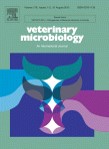
| Judul | Animal models to study the pathogenesis of human and animal Clostridium perfringens infections / McClane, Bruce A.[Department of Molecular Genetics and Biochemistry, University of Pittsburgh School |
| Pengarang | McClane, Bruce A.[Department of Molecular Genetics and Biochemistry, University of Pittsburgh School Uzal, Francisco A. [California Animal Health and Food Safety Laboratory, San Bernardino Branch, Facu Cheung, Jackie K. |
| EDISI | Vol.179 (2015) |
| Penerbitan | [s.l] : Elsevier Publishing, 2015 |
| ISBN | 0378-1135 |
| Subjek | CLOSTRIDIUM PERFRINGENS -- Alpha toxin -- Beta toxin -- Epsilon toxin -- Enterotoxin |
| Catatan | The most common animal models used to study Clostridium perfringens infections in humans and animals are reviewed here. The classical C. perfringens-mediated histotoxic disease of humans is clostridial myonecrosis or gas gangrene and the use of a mouse myonecrosis model coupled with genetic studies has contributed greatly to our understanding of disease pathogenesis. Similarly, the use of a chicken model has enhanced our understanding of type A-mediated necrotic enteritis in poultry and has led to the identification of NetB as the primary toxin involved in disease. C. perfringens type A food poisoning is a highly prevalent bacterial illness in the USA and elsewhere. Rabbits and mice are the species most commonly used to study the action of enterotoxin, the causative toxin. Other animal models used to study the effect of this toxin are rats, non-human primates, sheep and cattle. In rabbits and mice, CPE produces severe necrosis of the small intestinal epithelium along with fluid accumulation. C. perfringens ty |
| Bahasa | Tidak tersedia |
| Bentuk Karya | Tidak ada kode yang sesuai |
| Target Pembaca | Tidak ada kode yang sesuai |
| No Barcode | No. Panggil | Akses | Lokasi | Ketersediaan |
|---|---|---|---|---|
| vm-vol.179-2015-23 | vm-vol.179-2015-23 | Dapat dipinjam | Perpustakaan Balai Besar Perakitan dan Modernisasi Veteriner - Ruang Baca Umum | Tersedia |
| Tag | Ind1 | Ind2 | Isi |
| 001 | INLIS000000000014408 | ||
| 005 | 20240213022339 | ||
| 008 | 240213################|##########|###### | ||
| 020 | # | # | $a 0378-1135 |
| 035 | # | # | $a 0010-0521014408 |
| 041 | $a en | ||
| 082 | # | # | $a NONE |
| 090 | $a vm-vol.179-2015-23 | ||
| 100 | 0 | # | $a McClane, Bruce A.[Department of Molecular Genetics and Biochemistry, University of Pittsburgh School |
| 245 | 1 | # | $a Animal models to study the pathogenesis of human and animal Clostridium perfringens infections /$c McClane, Bruce A.[Department of Molecular Genetics and Biochemistry, University of Pittsburgh School |
| 250 | # | # | $a Vol.179 (2015) |
| 260 | # | # | $a [s.l] :$b Elsevier Publishing,$c 2015 |
| 500 | # | # | $a The most common animal models used to study Clostridium perfringens infections in humans and animals are reviewed here. The classical C. perfringens-mediated histotoxic disease of humans is clostridial myonecrosis or gas gangrene and the use of a mouse myonecrosis model coupled with genetic studies has contributed greatly to our understanding of disease pathogenesis. Similarly, the use of a chicken model has enhanced our understanding of type A-mediated necrotic enteritis in poultry and has led to the identification of NetB as the primary toxin involved in disease. C. perfringens type A food poisoning is a highly prevalent bacterial illness in the USA and elsewhere. Rabbits and mice are the species most commonly used to study the action of enterotoxin, the causative toxin. Other animal models used to study the effect of this toxin are rats, non-human primates, sheep and cattle. In rabbits and mice, CPE produces severe necrosis of the small intestinal epithelium along with fluid accumulation. C. perfringens type D infection has been studied by inoculating epsilon toxin (ETX) intravenously into mice, rats, sheep, goats and cattle, and by intraduodenal inoculation of whole cultures of this microorganism in mice, sheep, goats and cattle. Molecular Koch's postulates have been fulfilled for enterotoxigenic C. perfringens type A in rabbits and mice, for C. perfringens type A necrotic enteritis and gas gangrene in chickens and mice, respectively, for C. perfringens type C in mice, rabbits and goats, and for C. perfringens type D in mice, sheep and goats. |
| 650 | 4 | $a CLOSTRIDIUM PERFRINGENS -- Alpha toxin -- Beta toxin -- Epsilon toxin -- Enterotoxin | |
| 700 | 0 | # | $a Cheung, Jackie K. |
| 700 | 0 | # | $a Uzal, Francisco A. [California Animal Health and Food Safety Laboratory, San Bernardino Branch, Facu |
Content Unduh katalog